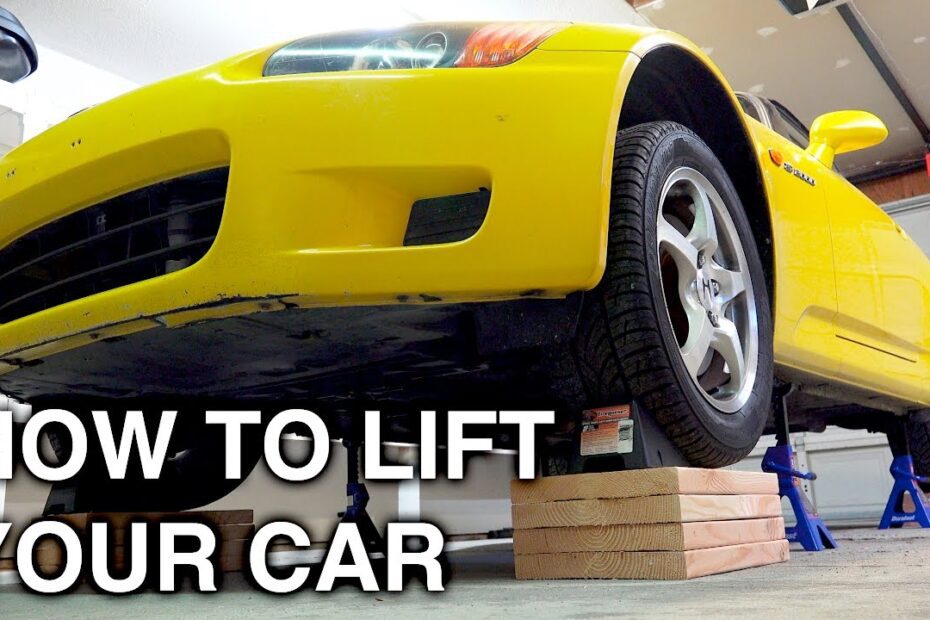Lifting a car without a lift kit can be done with the use of jacks and stands. First, place two jack stands at either side of the car near its frame then set up one hydraulic floor jack under the engine cradle. Make sure that the floor jack is centered on its location before beginning to lift it.
Slowly begin to raise the car until you reach your desired height, ensuring that it is stable as you do so. Once lifted securely, insert and secure both jack stands onto their respective sides, making sure they are properly in place before removing the floor jack from underneath the car. Finally, double-check all areas of stability before getting underneath or working on any automotive parts.
- Step 1: Gather the necessary tools and equipment: Jack stands, a floor jack, safety glasses and work gloves
- Step 2: Park your car on level ground
- Make sure that the ground is firm enough to support the weight of your vehicle while it’s elevated
- Step 3: Securely position two jack stands under each end of the car frame, near where you plan to raise it with a floor jack
- Step 4: Slowly lift up one corner of the car using a floor jack until it reaches its maximum height as indicated by its safety valve or lever
- Step 5: Place additional supports beneath any other areas where you plan to raise or lower parts of the vehicle for repairs or maintenance activities
- Step 6: Once all parts have been securely supported, slowly lower each part back down onto their supports before removing them from underneath your vehicle

Credit: www.avrautomotive.com.au
Can You Lift a Vehicle Without a Lift Kit?
No, you cannot lift a vehicle without a lift kit. A lift kit is the most effective way to raise the suspension on your ride and provide additional ground clearance for larger tires and wheels. Lift kits are designed to provide optimal performance in off-road driving conditions, as well as give vehicles an impressive look of ruggedness.
Depending on the type of vehicle, different types of lift kits exist such as body lifts, shackle lifts or spring spacers which are all designed to use either factory or aftermarket components that help raise the desired height needed when lifting your car or truck. Without having one installed it would be impossible to properly and safely raise your vehicle’s suspension level with any degree of accuracy and stability; making them absolutely essential for anyone looking to increase their vehicles overall altitude without compromising its structural integrity.
How Can I Increase the Height of My Car?
If you’re looking to increase the height of your car, there are several ways to do so. You can install a body lift kit, which is designed for off-road vehicles and lifts the frame of your vehicle away from its axles by using space between the frame and axles with blocks or spacers. Alternatively, you could look into installing a suspension lift kit that raises your entire vehicle up higher than it was originally.
This type of modification includes replacing factory components like coil springs and shock absorbers with taller versions to raise ride height while maintaining handling performance. If more ground clearance is what you desire, consider fitting larger tires on your car as they will also provide an increase in overall height. Lastly, adding wheel spacers between the hub and wheel can give additional axle clearance without changing tire size or suspension geometry; however please note that this should only be done after consulting a professional mechanic due to safety concerns about doing so correctly.
How Do You Lift a Car Up Without a Jack?
Without a jack, lifting a car up can be tricky; however, there are some methods you can use to get the job done. One option is to use an engine hoist or crane. These devices have large hooks that attach to the frame of your vehicle and allow you to lift it with ease.
Another option is to build ramps out of sturdy materials such as lumber and bricks. You’ll need two sets of ramps for this method – one set under each side of the vehicle – which will enable you to drive it up onto them before pushing down on its sides until it’s elevated off the ground enough for you to access what needs doing underneath. A more labor-intensive approach involves using two jacks—one at each end of your car—and then placing wood blocks between them in order for increased support when lifting the vehicle off the ground.
Finally, if all else fails, why not enlist some friends? If everyone takes hold of their own portion of the car and lifts together in unison (with safety precautions taken!) then this could also work just as effectively!
How Can I Raise My Car at Home?
If you want to raise your car at home, there are a few things you need to consider. First, make sure that the area in which you will be working is large enough and flat enough for the job. Second, invest in a quality jack and some sturdy stands or blocks that can support your vehicle while it’s raised off of the ground.
You should also have plenty of wheel chocks on hand to use as an extra precaution when raising your car (especially if you plan on getting under it). Finally, before tackling any job involving lifting up your car, make sure that all four wheels are securely blocked and double-check them often throughout the process for maximum safety. Once these steps are taken care of, proceed with caution and follow step-by-step instructions provided by the jack manufacturer or consult an experienced mechanic if necessary.
With these tips in mind, taking on this task yourself should be relatively straightforward – just remember not to take any shortcuts!
Making A Custom Lift Kit & Straight-Piping The Mud-Type
Homemade Ways to Lift Your Truck
If you’re looking for an inexpensive way to lift your truck, there are plenty of DIY solutions that can help. You can use a combination of blocks and airbags to raise the height of your vehicle at home. Blocks can be used on the front or rear suspension while airbags should only be used on the rear suspension.
With these modifications, you’ll be able to get extra clearance when driving off-road or increase ground clearance for better performance.
How to Lift a Car Without a Jack
Using a jack is the easiest and safest way to lift a car, but it is possible to do so without one. If you find yourself in an emergency situation where no jack is available, you can use some basic items like large rocks, boards or blocks of wood to raise the car slightly off the ground. Place them securely under the frame close to each wheel and then carefully drive up onto them until they are supporting the weight of your vehicle.
Be sure that all four wheels are supported before attempting any repairs.
Homemade Lift Kit
A homemade lift kit is a great way to give your vehicle an extra boost of clearance and off-road performance. If you’re looking for a cost-effective solution, building your own lift kit with blocks and spacers can be an easy and affordable option. It requires some skill with tools, but the end result can be very rewarding.
With some patience and careful workmanship, you can create a lift that will have your truck or SUV standing tall on the trails in no time!
How to Lift Your Truck for Free
One way to lift your truck for free is by using suspension blocks. Suspension blocks are typically made from metal and designed to fit in the gap between the axle and frame of your truck, raising it up to a higher level. They are easy to install and provide an inexpensive option for lifting your vehicle without having to purchase additional parts or use professional services.
Conclusion
This blog post provides a detailed and informative guide on how to lift a car without the need for a lift kit. Although this task can be difficult, the steps provided make it easier to do safely and effectively. In conclusion, lifting a car without an expensive lift kit is possible with careful preparation and attention to detail.
Following these steps will help you achieve your desired results in an economical way that also ensures safety.
- Aggregate Dispatch Software: Revolutionize Your Logistics! - July 19, 2024
- Heavy Haul Dispatch Software: The Ultimate Efficiency Booster - July 8, 2024
- Intermodal Trucking Dispatch Software: Streamline Logistics! - June 27, 2024

